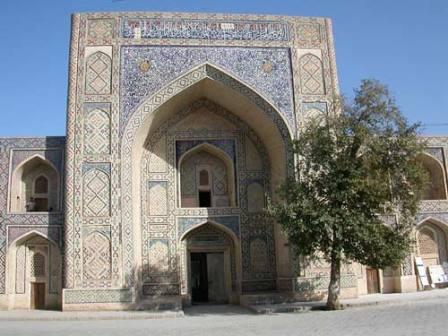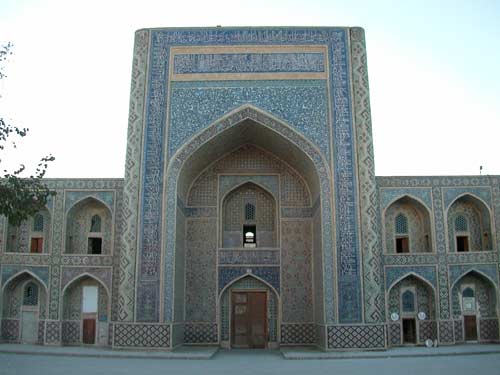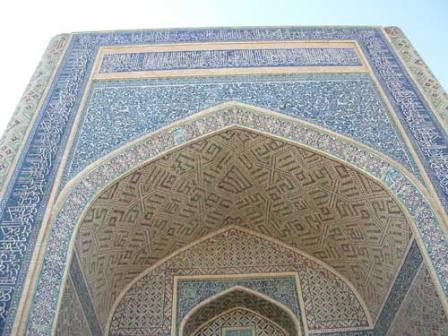|
Category
|
Kosh-Madrasah ensemble: Madrasah Modari Khon and Abdullah Khan madrassah
The first of them - the madrassa Modari hon built in honor of the mother Abdullah Khan II. "Modari hon" is translated from Farsi means "mother of Khan". Date of construction - 947 Hijra year (1566/67 years). Specified in the poetic with majolica inscription over the entrance. The composition is a "typical" school of time to the hostel students and teachers around the yard, community halls and classrooms of the mosque - "darskhona" in front of the building, on both sides of the portal.  The main facade is richly faced with multicolor brick mosaic. The main feature of the madrassa is planning a trapezoidal shape of the building because of the location of the facade at an angle to the main volume of the building as an existing street is not possible to correctly orient the building while maintaining a rectangular layout. The decoration of the facade complement the tympans of the painted majolica tiles depicting the flower buds. All artistic decoration madrassa looks very modestly. The second building - Abdullah Khan Madrassah, built in 1588-90 years, one of the outstanding works of Central Asian architecture. The main entrance of the madrasa, decorated as high portal. The large size and diversity of decorative facade of giving it a colorful, festive look. In bright sunlight, play a variety of shades of cool colors majolica tiles (red, green, blue, white). Madrassah of Abdullah Khan - one of the largest madrasa in Bukhara after Kukeldash and Miri-Arab. I Kosh madrassah Ensemble, which stands at some distance from the central cluster of different mosques and madrasas, clearly stands out in Bukhara architecture. A well-preserved mosaics on the walls of Madrasah fascinate its harmony and elegance. |
 In the same area, where the mausoleum of the Samanids and the Chashma-Ayub Mausoleum, near the park, is one of the most attractive and elegant architectural ensemble typical of Bukhara - Kosh madrassah ensemble. "Kosh" - meaning "double, pair", as the building of madrasas are opposite each other on the sides of the street, as if exchanging glances with each other.
In the same area, where the mausoleum of the Samanids and the Chashma-Ayub Mausoleum, near the park, is one of the most attractive and elegant architectural ensemble typical of Bukhara - Kosh madrassah ensemble. "Kosh" - meaning "double, pair", as the building of madrasas are opposite each other on the sides of the street, as if exchanging glances with each other. n the traditional architecture of madrassah’s of Bukharian school made their own local circumstances, appears to be in the XV century noticeable when comparing the earliest surviving in the Central Asian madrassas, built the famous ruler-scientist - Ulugbek in Bukhara, Samarkand and Gizhduvan. Ulugbek Madrasah in Samarkand, for example, had a blank facades and tall slender minarets at the corners of the building. In Bukhara, the main facade of arched loggias disclosed, but on the corners of the building instead of minarets - squat tower "guldasta" cut at the level of the lateral wings. Bukhara madrasahs differed and planning features.
n the traditional architecture of madrassah’s of Bukharian school made their own local circumstances, appears to be in the XV century noticeable when comparing the earliest surviving in the Central Asian madrassas, built the famous ruler-scientist - Ulugbek in Bukhara, Samarkand and Gizhduvan. Ulugbek Madrasah in Samarkand, for example, had a blank facades and tall slender minarets at the corners of the building. In Bukhara, the main facade of arched loggias disclosed, but on the corners of the building instead of minarets - squat tower "guldasta" cut at the level of the lateral wings. Bukhara madrasahs differed and planning features. 














